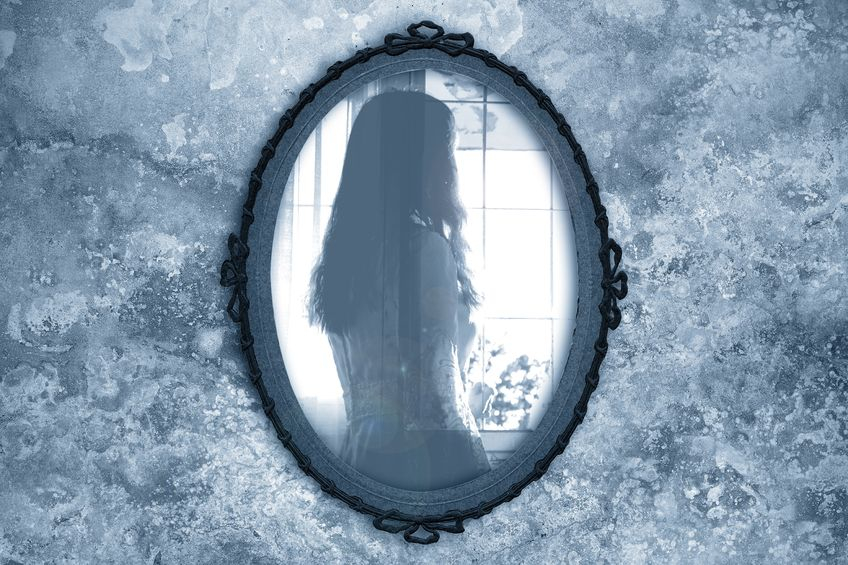Psychomanteum
A psychomanteum is a small, dark chamber used to facilitate communication with a particular departed soul. Its origin stems from an ancient Greek ritual for contacting those in the spirit realm. At that time, individuals were led through an underground maze to a dimly lit place so they would be away from outside stimuli. In that area was a cauldron or bowl filled with water or oil. The person would gaze directly into the cauldron, look at and focus on his own reflection in the hope that the spirit would appear.
This was actually an early form of scrying, which is a type of divination used to predict the future by gazing into a crystal ball (crystallomancy), other shiny object or reflective surface. Reflective surfaces were believed to be a portal to the spirit world. Throughout ancient history, many cultures have used other methods, using herbs, plants, smoke or drumming, to induce an altered state of mind to achieve a higher consciousness in order to contact spirits for guidance, to answer questions, to heal and to connect with ancestors who had passed.
The earliest known term used for these chambers was psuchomanteia. In the 20th century, Raymond Moody, M.D., Ph.D., grief counselor, respected researcher in near-death experiences and author of Life after Life and other works, was inspired by the writings of Herodotus about the Oracle of the Dead and Homer in The Odyssey, in which they described these chambers. Moody believed that such a chamber would help individuals through the grieving process after the death of a loved one or friend. The time spent contacting and connecting with those in the spirit realm would help or create a powerful impact on emotional healing. Moody recreated a modern-day chamber and called it a psychomanteum. Currently, his work in the field continues, and he lectures, consults and researches on this topic, as well as others.
Moody’s psychomanteum chamber was a small, dimly lit room (approximately the size of a walk-in closet) with a mirror on one wall and a comfortable chair directly facing the mirror. It was intentionally hung so that the individual sitting in the chair was unable to see his or her own reflection. This was not the case in ancient psychomanteums, in which the individual stared at his own reflection while gazing into a reflective surface. Placed behind the chair was a lamp with a low-wattage bulb. Additionally, a black velvet curtain surrounded the chair to create a nestled and secure environment for the individual. Doing that was a form of sensory deprivation, which was used to block all external stimuli, thus allowing the mind of the individual sitting in the chair to focus only on the intended spirit that was to be contacted.
Before participating in the initial chamber testing, a rigorous selection process for potential subjects was put in place. Moody devised specific methods to prepare the selected participants for the experience. He encouraged them to dress in comfortable attire, to bring an object or picture that evoked strong memories of the deceased and to share their deepest feelings and experiences with him, either positive or negative. Moody continued to relax the participants by walking leisurely and talking about the grieving process and the expectations of the psychomanteum experience. To get his subjects even more relaxed and get them closer to a true meditative state, he had them also lie down and listen to soft music before entering the chamber.
The actual time spent in the psychomanteum was a mere 45 minutes to one hour, while in comparison, the preparation for it took quite a few hours. After each session in the room ended, he would discuss the experience in-depth with the participant.
Moody never guaranteed a connection with those who had passed during the time in the psychomanteum. People’s experiences within the chamber varied. In some cases, the spirit that the person hoped to contact did in fact appear to deliver a message, some final words or just some extra time that was needed between the two. In other cases, another spirit who had a relationship with the person appeared and offered similar comfort or an important message.
Sometimes, subjects experienced a feeling that a comforting presence was in the room, being touched by the apparition, a consoling hug, a gentle stroke on the hand or face, or the spirit appearing as if it were once again in human form. Moody reported that regardless of what did or did not “appear” from the spirit realm during the time spent in the room, the subjects had positive reactions to it and felt comforted, at peace and gained much needed closure regarding the passing of their departed.
Today, the purpose of the psychomanteum has been expanded to include not just bereavement and contacting spirits. It has become a key tool in helping people to attain a greater knowledge of the Self and to provide the ability to achieve a higher consciousness, which can aid in clarifying change and major life decisions.
For more information on developing psychic abilities, visit the Learning Room.

